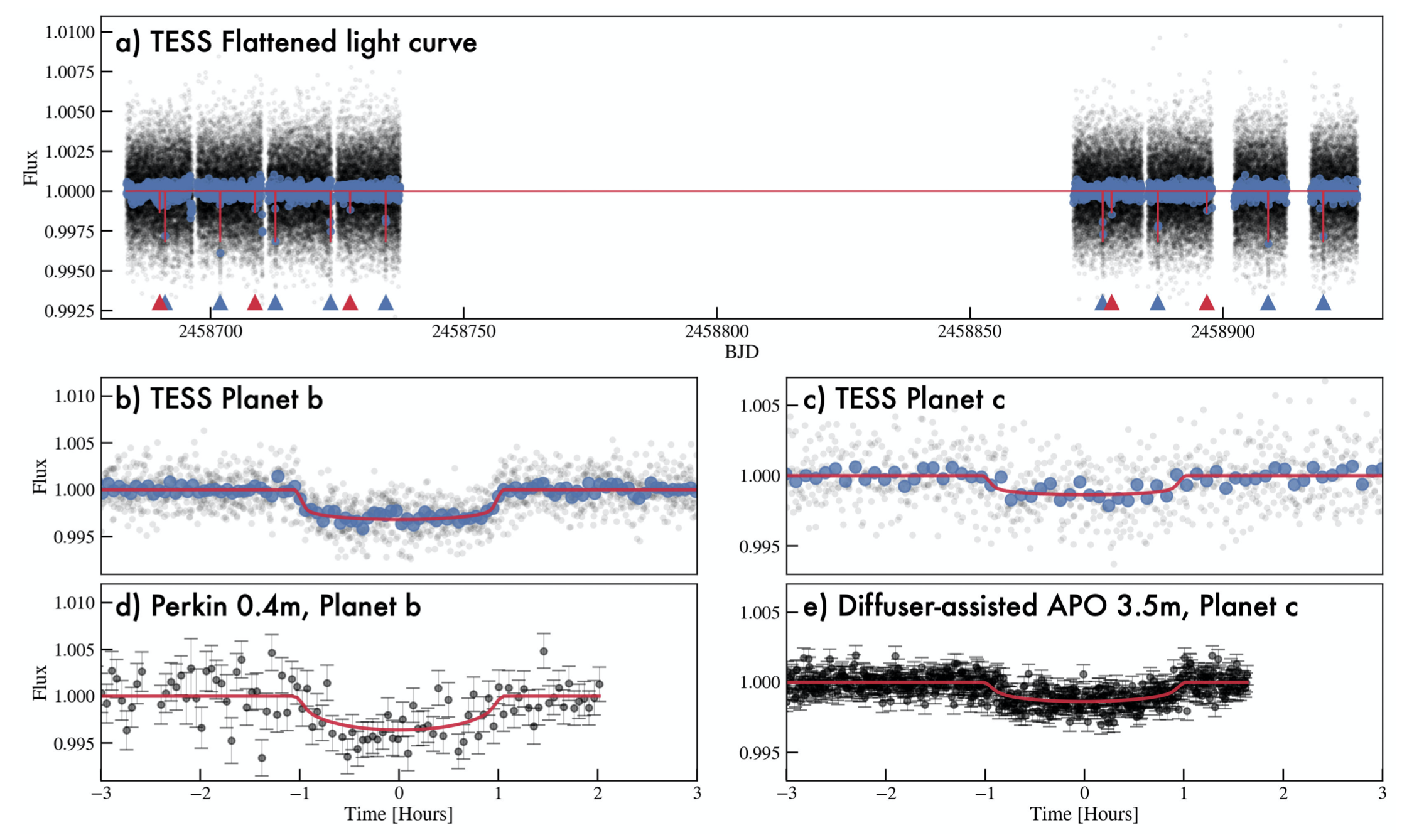STATUS UPDATE: AU Mic feature published! Check out details below.
Hello TESS followers and welcome to this week's news bulletin! This week we present four papers using TESS data.
A planet within the debris disk around the pre-main-sequence star AU Microscopii (Plavchan et. al., 2020): AU Microscopii (AU Mic) is a neighboring pre-main sequence star only 22 million years old and located 31.9 light years away in the southern constellation Microscopium. This cool red dwarf star possesses an edge-on debris disc and within this disc a planet transit has been detected! Using TESS and Spitzer observations, physical properties of the planet, known as AU Mic b, have been derived. It possesses an orbital period of 8.46 days, is located at a distance of 0.07 AU from the host, has a radius of 0.4 RJup, and mass less than 0.18 MJup. For more information on this fascinating object please see our feature page. AU Mic b is also featured in a new NASA poster available in English and Spanish, as part of a Galaxy of Horrors series. Download your copy here
A Mini-Neptune and a Venus-Zone Planet in the Radius Valley Orbiting the Nearby M2-dwarf TOI-1266: Validation with the Habitable-zone Planet Finder (Stefansson et. al., 2020): Two planets are validated within this paper using TESS data. The planets orbit an M2 dwarf known as TOI-1266 which is 36pc away. The inner planet is a sub-Neptune with a radius of 2.46 R⊕ and an orbital period of 10.9 days. The outer planet is smaller with a radius of 1.67 R⊕, has an orbital period of 18.8 days, and is in the exoplanet Radius Valley, a region of transition between rocky and gaseous planets. Given the outer planet's location it receives 2.4 times the amount of insolation flux compared to the Earth, this is similar to that for Venus.
Optical detection of the 1.1-day variability at the white dwarf GD 394 with TESS (Wilson et al., 2020): This paper uses TESS data to examine GD 394, a hot white dwarf which exhibits a unique 1.15 d flux variation which was detected by the Extreme Ultraviolet Explorer (EUVE) back in the mid 1990's. The variation of this object is unknown but several hypothesis exist including channeled accretion producing a dark spot of metals, occultation by a gas cloud from an evaporating planet, or heating from a flux tube produced by an orbiting iron-cored planetesimal. The TESS observations presented here are the first outside of the EUV regime and demonstrate a 0.12% flux variation with a period of 1.146 d, which is consistent with the EUVE measurements.
The Compact Triply Eclipsing Triple Star TIC 209409435 Discovered with TESS (Borkovits et. al., 2020): In Sectors 3 and 4 of TESS data a compact triple eclipsing star system was discovered by the authors. TIC 209409435 is a previously unknown eclipsing binary with a period of 5.717 days and a third star found in an eccentric orbit with a period of 121.872 days. This third star exhibits signatures of strong 3rd-body perturbations. After much analysis and study, the authors find that the inner binary consists of near twin stars of mass 0.9 M⊙, and radius 0.88 R⊙. The third star is 9% more massive and has and 18% larger radius. The eccentricity of the inner binary is small while the outer orbit has e=0.40. The inner binary and outer orbit have inclination angles within 0.1° and 0.2° of 90°, respectively.
Fig 1: Image credit NASA-JPL/Caltech. Located less than 32 light-years from Earth, AU Microscopii is among the youngest planetary systems ever observed by astronomers, and its star throws vicious temper tantrums! You’ve heard of the “terrible twos”? Well, AU Mic is in the midst of its terrible 22 … millions! This devilish young system holds planet AU Mic b captive inside a looming disk of ghostly dust and ceaselessly torments it with deadly blasts of X-rays and other radiation, thwarting any chance of life… as we know it! Beware! There is no escaping the stellar fury of this system. The monstrous flares of AU Mic will have you begging for eternal darkness.

Fig 2: Taken from Stefansson et al., (2020). Transit photometry of TOI-1266. a) The 2-min TESS photometry shown in black, blue points represent data binned into 10-min, the red curve shows the best-fit joint model including both planets. The blue and red triangles mark the transits of planets b and c. b-c) Phase folded photometry from TESS of the transits of TOI-1266b and TOI-1266c. d) Ground-based photometry from the 0.4m Perkin Telescope showing the transit of TOI-1266b. e) Diffuser-assisted photometry during the transit of TOI-1266c using the Engineered Diffuser at the Apache Point Observatory.